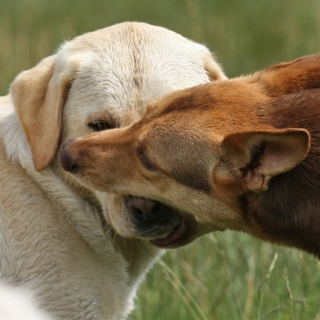Why Do Dogs Muzzle Grab One Another?

A "Muzzle grab" (as shown in this photo of Marco de Kloet) is a common behavior shown by social canines, e.g. wolves (Canis lupus lupus), dingoes (Canis lupus dingo), and dogs (Canis lupus familiaris).
The function of this behavior is to confirm a relationship rather than to settle a dispute. The more self-confident individual will muzzle grab a more insecure opponent and thus assert its social position. The more insecure individual does not resist the muzzle grab. On the contrary, it is often the more insecure individual that shows submissive behavior by literally inviting its opponent to muzzle grab it. Even though we sometimes see this behavior at the end of a dispute, wolves and dogs only use it toward individuals they know well (pack members) almost as way of saying "You're still a cub (pup)." The dispute itself does not tend to be serious, just a low-key challenge, normally over access to a particular resource. Youngsters, cubs and pups sometimes solicit adults to muzzle grab them. This behavior appears to be reassuring for them, a means of saying, "I'm still your cub (pup)."
The muzzle grab behavior emerges early on. Canine mothers muzzle grab their puppies (sometimes accompanied by a growl) to deter them from suckling during weaning. Cubs and pups also muzzle grab one another during play, typically between six and nine weeks of age. They probably learn through play that the muzzle grab is a good way of stopping an opponent from doing something. Cubs and pups also learn the importance of bite inhibition when showing muzzle grab. If they bite their opponent too hard, they will elicit a fight and will get hurt. A muzzle grab, therefore does not involve biting, just grabbing. This behavior helps develop a relationship of trust between both parties: "We don't hurt one another."
When used as a means of settling a dispute, a muzzle grab looks more violent and normally ends with the muzzle-grabbed individual showing passive submissive behavior. However, the participants very seldom get hurt, an occurrence that would counteract the function of the behavior itself.
A muzzle grab requires self control. Higher ranking wolves and dogs muzzle grab their pack members (team mates) and by doing so confirm their rank and display self control. Lower ranking wolves and dogs invite muzzle grabbing behavior in order to confirm their acceptance of their social position and to reassure themselves that they are still accepted.
The muzzle grab behavior probably originated as both a form of maternal (paternal) behavior and as a play behavior amongst cubs (pups). As it proved beneficial to all concerned, it became a factor for natural selection and spread from generation to generation, evolving in the same way as any other trait that increases the fitness of an individual.
In domestic dogs, when the puppies are five to seven weeks old, their mother muzzle grabs them regularly. At first, their mother's behavior frightens them and they may whimper excessively, even if the mother has not harmed them in any way. Later on, when grabbed by the muzzle, the puppy immediately shows passive submission (lies down with its belly up). Previously, it was assumed that the mother needed to pin the puppy to the ground, but this is not the case as most puppies submit voluntarily. Over time, this behavior pattern assumes variations. Wolf cubs and puppies often invite the alpha male (leader of the pack) as well as other adults to grab them by the muzzle. They solicit a demonstration of their elders’ superiority and self control, whilst at the same time they show their acceptance and submission. This is the most reassuring behavior an adult dog can show a puppy.
Domestic dogs sometimes approach their owners puffing to them gently with their noses. By grabbing them gently around the muzzle, we reaffirm our acceptance of them, our self-control and our control of the environment in general. After being muzzle grabbed for a while, the dog will normally show a nose lick, maybe yawn and then walk calmly away. It's like the dog saying, "I'm still your puppy" and the owner saying, "I know and I'll take good care of you."
The muzzle grab behavior can be difficult to classify. Some researchers classify it as social behavior, others as agonistic behavior and a third group places it in the distinct category of pacifying behavior. Since the function of this behavior is primarily to confirm a relationship between two individuals, this author classifies it as social behavior.
Enjoy your day!
R—
You can read more here. Photo by Marco de Kloet.




